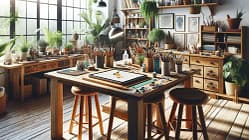When it comes to digital images, there are two main types: raster and vector. Raster images, also known as pixel-based images, are created using tiny individual colored squares called pixels. These pixels combine to create the overall image. Raster images are commonly used for photographs, digital paintings, and other complex images that require a high level of detail and color variation.

Learn Procreate for Beginners
FREE CLASS with everything you need to know
about Procreate for digital painting.
Pixel-Based Images
Raster images are made up of a grid of pixels, each of which has a specific color value. The more pixels an image has, the higher its resolution, which means that it will be sharper and more detailed. However, high-resolution raster images can also be very large in file size, which can make them difficult to work with. Pixel-based images are created by taking photographs with digital cameras, scanning physical images, or using digital painting software (just as Procreate). Common file types for pixel-based images include JPEG, PNG, and TIFF.
Pixel-based image: left in high resolution, on the right zoomed in - you can see the single pixels
Uses of Raster Images
Raster images are used for a wide variety of purposes, including:
Photographs: Photographs are almost always raster images because they require a high level of detail and color accuracy.
Digital Painting: Digital painting software, such as Adobe Photoshop and Procreate, is designed for creating pixel-based images that simulate traditional painting techniques.
Graphic Design: While vector images are typically preferred for logos and other graphics that require scalability, raster images are still commonly used in graphic design for complex illustrations, textures, and backgrounds.
Website Design: Raster images are commonly used in website design, such as for hero images or background patterns.
Printing: Raster images are commonly used for printing, especially for high-quality printing on glossy paper.
In conclusion, pixel-based images, or raster images, are created using pixels to create the overall image. They are commonly used for photographs, digital paintings, and other complex images that require a high level of detail and color variation. Raster images are used in a wide variety of applications, including graphic design, website design, and printing.
Vector-Based Images
Vector images, unlike raster images, are created using mathematical equations to define lines and curves rather than pixels. These images are made up of paths, curves and shapes, which can be resized and edited without losing quality. Vector images are commonly used for logos, typography, and other graphics that require scalability and precision. Vector images are created using specialized software such as Adobe Illustrator or Affinity Designer.
Uses of Vector Images
Vector images are used for a wide variety of purposes, including:

In conclusion, vector images are created using mathematical equations to define lines and curves, rather than pixels. They are commonly used for logos, typography, and other graphics that require scalability and precision. Vector images are used in a wide variety of applications, including graphic design, packaging design, web design, and illustration.
In the Safari Lounge we take care of both image types. We draw in Procreate and create raster-images. But we also use Affinity Designer and create our own vector-based clipart.

Learn Procreate for Beginners
FREE CLASS with everything you need to know
about Procreate for digital painting.
